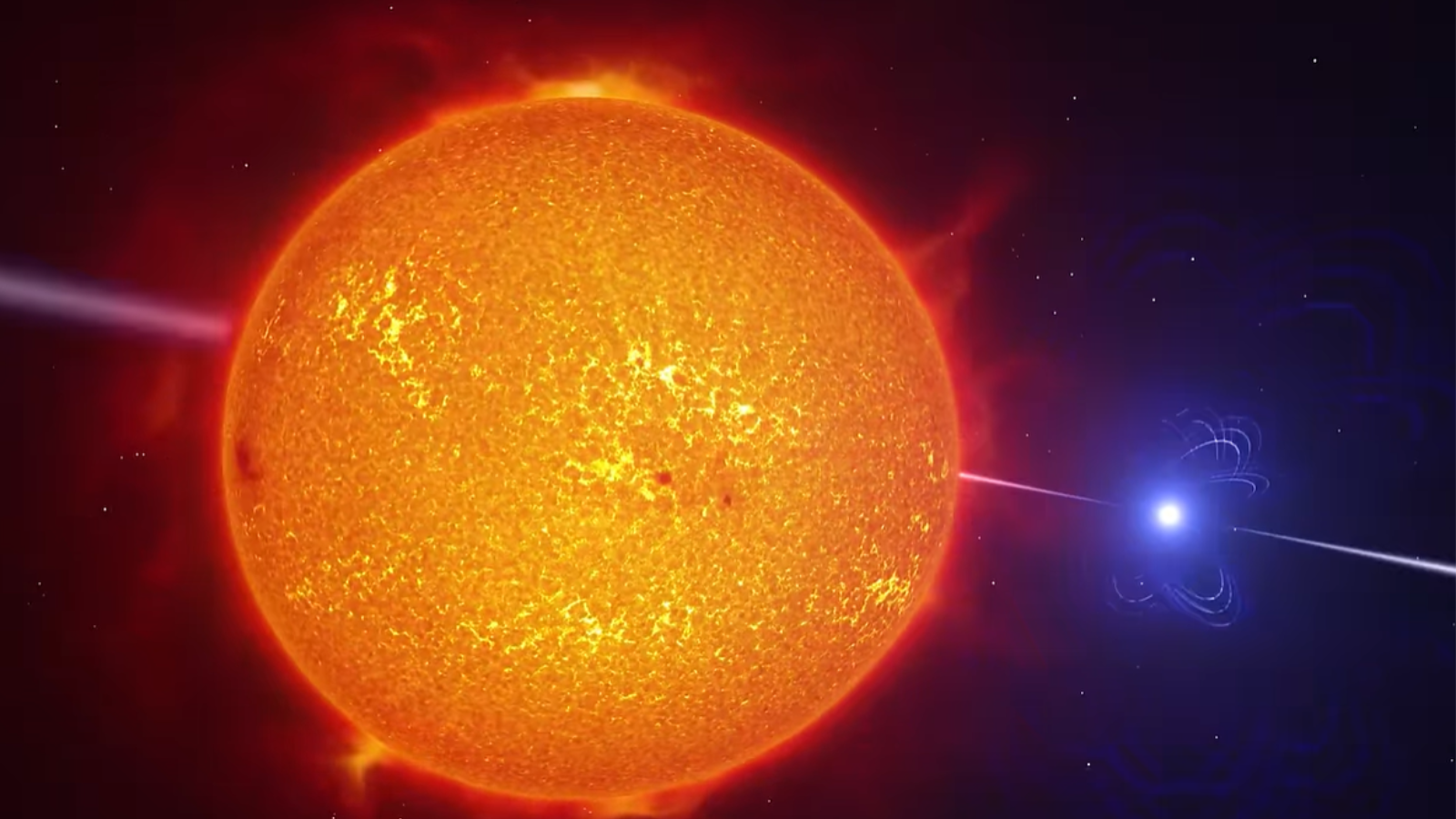Mysterious, record-breaking energy burst connected to dead star and red dwarf
"An M dwarf alone couldn't generate the amount of energy we're seeing. Our data suggests that it is in a binary with another object, which is likely to be a white dwarf, the stellar core of a dying star."

Astronomers have discovered a record-breaking burst of energy coming from deep space, tracing it to a binary system containing a tiny red dwarf star and a dead stellar remnant called a white dwarf.
The team from the Curtin University node of the International Center for Radio Astronomy Research (ICRAR) discovered the pulse of bright energy in archival low-frequency data from the Murchison Widefield Array (MWA). This radio wave pulse, designated GLEAM-X J0704-37, erupts every three hours, with these bursts lasting between 30 and 60 seconds. That makes this signal the longest-period example of a rare and extreme phenomenon called "long-period radio transients."
First discovered in 2006, astronomers have been puzzled by long-period radio transients for almost 20 years, unable to figure out how exactly they generate radio waves. This research may have solved that mystery by identifying a probable source of these energy bursts.
One reason the mystery has been so tricky is that previously discovered long-period radio transients sat within areas of the Milky Way packed with stars. That has made it tough to hone in on what is actually generating these bursts of radio waves.
"The long-period transients are very exciting, and for astronomers to understand what they are, we need an optical image," Natasha Hurley-Walker, discovery team member and a researcher at Curtin University, said in a statement. "However, when you look toward them, there are so many stars lying in the way that it's like 2001: A Space Odyssey. 'My god, it’s full of stars!'"
However, the team had a stroke of luck when discovering GLEAM-X J0704-37. This remarkable long-period radio transient originated from 5,000 light-years away at the edge of the Milky Way, which is more sparsely populated by stars.
"Our new discovery lies far off the galactic plane, so there are only a handful of stars nearby, and we're now certain one-star system, in particular, is generating the radio waves," Hurley-Walker added.
Breaking space news, the latest updates on rocket launches, skywatching events and more!
The team used the MeerKAT telescope in South Africa to pinpoint the origin of GLEAM-X J0704-37 to one specific star. The next step for the researchers was to uncover the nature of the GLEAM-X J0704-37 emitting star system.
Red dwarf vs. white dwarf
Turning to the Southern Astrophysical Research Telescope (SOAR) in Chile, the scientists were able to determine that one of the stars at the source of GLEAM-X J0704-37 is a low-mass red dwarf star, also known as an "M-class," or "M-dwarf," star.
This presented a dilemma for the team.
"The M dwarfs are low-mass stars that have a mere fraction of the sun's mass and luminosity. They constitute 70% of the stars in the Milky Way, but not one of them is visible to the naked eye," Hurley-Walker explained. "An M dwarf alone couldn’t generate the amount of energy we’re seeing."
Returning to their data, the team found evidence suggesting that the red dwarf is in a binary system with another object. They determined that this companion body is likely to be a white dwarf, the cooling stellar ember that is left over when a star with a mass around that of the sun dies.
"Together, they power radio emission," Hurley-Walker pointed out.
Hurley-Walker and colleagues propose that strong magnetic fields in the system cause the emission of periodic blasts of energy similar to those seen from rapidly spinning neutron stars, or "pulsars." Because the system from which GLEAM-X J0704-37 emerges is located high above the disk of the Milky Way, the researchers were able to rule out a highly magnetic neutron star, or "magnetar," as the source of this long-period radio transient.
The team is now hard at work scouring data to confirm the nature of this binary system and explain exactly how it launched GLEAM-X J0704-37.
More generally, the fact that GLEAM-X J0704-37 has been active for the last 10 years, remaining undiscovered until now, suggests there are likely many more long-period radio transients lurking in archival data from a wide range of telescopes across the globe, including the MWA.
"These long-period radio transients are new scientific discoveries, and the MWA has fundamentally enabled the discoveries," MWA Director Steven Tingay, said in the statement. "The MWA has a 55-petabyte archive of observations that provide a decade-long record of our universe. It is like having the data storage equivalent of 55,000 high-end home computers – one of the biggest single collections of science data in the world.
"It is an absolute gold mine for discovering more phenomena in our universe, and the data are a playground for astronomers."
The team's research was published on Nov. 26 in the Astrophysical Journal Letters.

Robert Lea is a science journalist in the U.K. whose articles have been published in Physics World, New Scientist, Astronomy Magazine, All About Space, Newsweek and ZME Science. He also writes about science communication for Elsevier and the European Journal of Physics. Rob holds a bachelor of science degree in physics and astronomy from the U.K.’s Open University. Follow him on Twitter @sciencef1rst.


